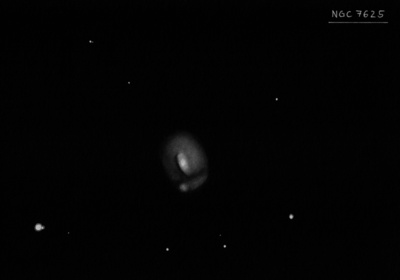
William Herschel discovered NGC 7625 = H II-250 = h2232 on 15 Oct 1784 (sweep 290) and recorded "F, lE, followed by a very bright star." He made another observation on 29 Nov 1785 (sweep 480) and noted "cB, S, R, mbM." On 7 Oct 1825 (sweep 11), John Herschel logged "B; R; sbM; 60"." A total of 8 observations were made at Birr Castle, mostly commenting on the irregular surface brightness. On 27 Sep 1857, Mitchell logged "south edge certainly brighter than the other, and a * or nucleus near that side, perhaps vF neby outside the s edge [the piece is cut off by dust]."
300/350mm - 13.1" (9/9/83): fairly bright, small, round, bright core. The dust lane on the southwest side was not seen. Located 6.8' WSW of mag 6.6 SAO 108560.
600/800mm - 24" (8/30/16): at 375x; bright, moderately large, roundish, well concentrated with a large bright core that is irregular and mottled and a small nucleus. The halo is much fainter and extends at least 1.0' diameter. With careful viewing I had the impression there was two close nuclei or perhaps a knot was close to the nucleus. The DSS and SDSS shows at least two intersecting dust lanes, though this feature was not confidently seen.
24" (9/10/15): at 260x; fairly bright, fairly small, round, ~40" diameter, small bright core that increases to a quasi-stellar nucleus. The absorption lane on the southwest side was not seen in poor transparency.
900/1200mm - 48" (10/28/19): viewed at 375x through thin clouds; very bright, fairly large, round, ~1.25' diameter, strong concentration with a very bright, slightly elongated or oval core. A low contrast dust lane wraps along the eastern edge of the core around to the south. The dust lane continues slicing through the galaxy towards the west, cutting off a southern piece of the galaxy, which mimicks the appearance of a broad spiral arm. A slightly brighter knot or patch is at the east end of this section, about 20" S of center. The outer halo was slightly fainter on the southeast side. Note: On the SDSS, there are two distinct, intersecting dust lanes, east and southwest of the core.
Notes by Steve Gottlieb